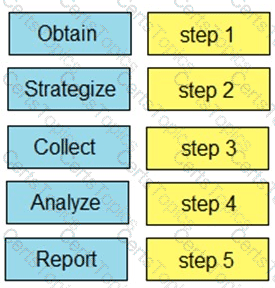A cybersecurity analyst is examining a complex dataset of threat intelligence information from various sources. Among the data, they notice multiple instances of domain name resolution requests to suspicious domains known for hosting C2 servers. Simultaneously, the intrusion detection system logs indicate a series of network anomalies, including unusual port scans and attempts to exploit known vulnerabilities. The internal logs also reveal a sudden increase in outbound network traffic from a specific internal host to an external IP address located in a high-risk region. Which action should be prioritized by the organization?
Drag and drop the steps from the left into the order to perform forensics analysis of infrastructure networks on the right.

An organization experienced a sophisticated phishing attack that resulted in the compromise of confidential information from thousands of user accounts. The threat actor used a land and expand approach, where initially accessed account was used to spread emails further. The organization's cybersecurity team must conduct an in-depth root cause analysis to uncover the central factor or factors responsible for the success of the phishing attack. The very first victim of the attack was user with email 500236186@test.com. The primary objective is to formulate effective strategies for preventing similar incidents in the future. What should the cybersecurity engineer prioritize in the root cause analysis report to demonstrate the underlying cause of the incident?
What is the steganography anti-forensics technique?